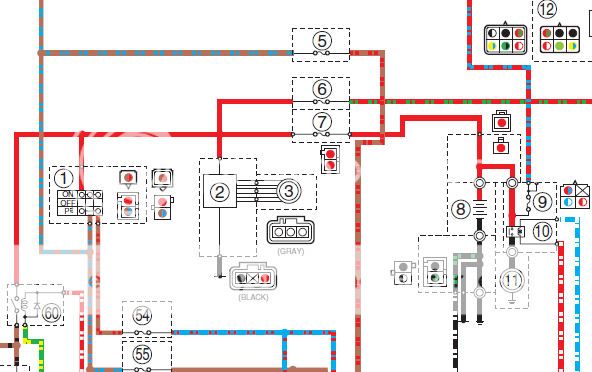I took my '09 FJR to a lunch date with my girlfriend today and ran a couple errands. It's one of the last nice days and I took today off. I wanted to be on the road today and enjoy the bike I've only had 4 months. I haven't had a bike since I was 18. I'm 42 now. For the last several years I've been wanting a bike but financially have had to say "next year" to that idea for many years. I've put 3200 miles on the bike since I got it. I haven't taken a long tour with it. I will next year though for sure. Anyway, when I got home from lunch and the errands I ran inside the house for about 10 minutes and ended up forgetting to turn the key off. It would't start. I tried bump starting it down the driveway a few times before I gave up and decided to jump it off my car. I pushed it up on the center stand and hooked the cables up. After a few minutes I decided it should be good and went to fire the bike up. I hit the starter and blew the 50 amp fuse. Damn. So I ran to the NAPA and picked one up. While there, I related my story to the parts guy and asked about battery chargers. He showed me a trickle charger cable that hooks to a trickle charger so it can be unplugged and plugged in anytime. It just had the positive lead and negative lead and an inline fuse and a special plug on the other end. I decided that was the way to go. I bought it and when I got home I went to install the new fuse. Space was tight and I couldn't easily get it lined up and ended up dropping the fuse behind where it was plugged in. I pulled the battery and got it... Then I went to hook the trickle charger cable up and realized that when I pulled the battery I paid no attention to the battery bolts and couldn't find them! I went to the hardware store and bought bolts, but when i tried them they wouldn't side into the opening and wouldn't work. I then went to the auto parts store and the parts guy there (it was a different parts store, the NAPA had closed) said that they didn't sell the bolts there but he scrounged and found some bolts and nuts for me. The bolts were smaller, but he didn't charge me so I was on my way back to try to fit them. Of course, they're too small and aren't going to work at all. So here I sit with my bike and no battery nuts. I have the bolts. Hey, at least I got around to cleaning my bike and putting on the frame sliders. They were the first and only farkle I've put on my bike. I read many of the topics on these forums and that was the most recommended farkle. I got the OES frame slider. The cleaning was necessary because I drove through a road construction job where they were laying fresh asphalt. My bike was caked with it. It doesn't want to come off easily. It was everywhere on the under carriage.
So, anyone have any thoughts or ideas. I figured I'd hit up the Yamaha dealer where I bought it tomorrow. I looked all over and found the fiche but it didn't have the battery, battery nuts or bolts.
This was the first time I had any of the panels off the bike. I took the hard bags and trunk off first thing this morning. It was only the second time I'd had those off. I'm loving learning the bike. It makes me feel even better about being an owner. My next challenge will be the first winter. I'll need to do some reading on winterizing and storing. I purchased the '09 4 months ago, it was brand new on the showroom floor.
So, anyone have any thoughts or ideas. I figured I'd hit up the Yamaha dealer where I bought it tomorrow. I looked all over and found the fiche but it didn't have the battery, battery nuts or bolts.
This was the first time I had any of the panels off the bike. I took the hard bags and trunk off first thing this morning. It was only the second time I'd had those off. I'm loving learning the bike. It makes me feel even better about being an owner. My next challenge will be the first winter. I'll need to do some reading on winterizing and storing. I purchased the '09 4 months ago, it was brand new on the showroom floor.































































